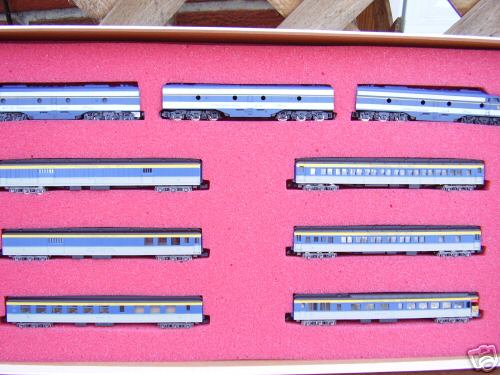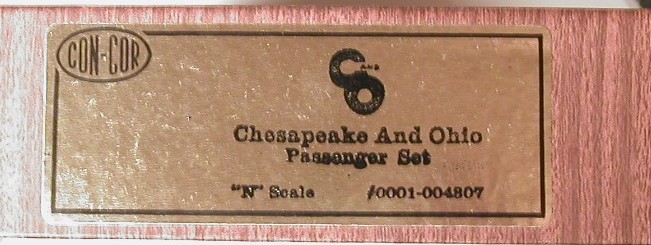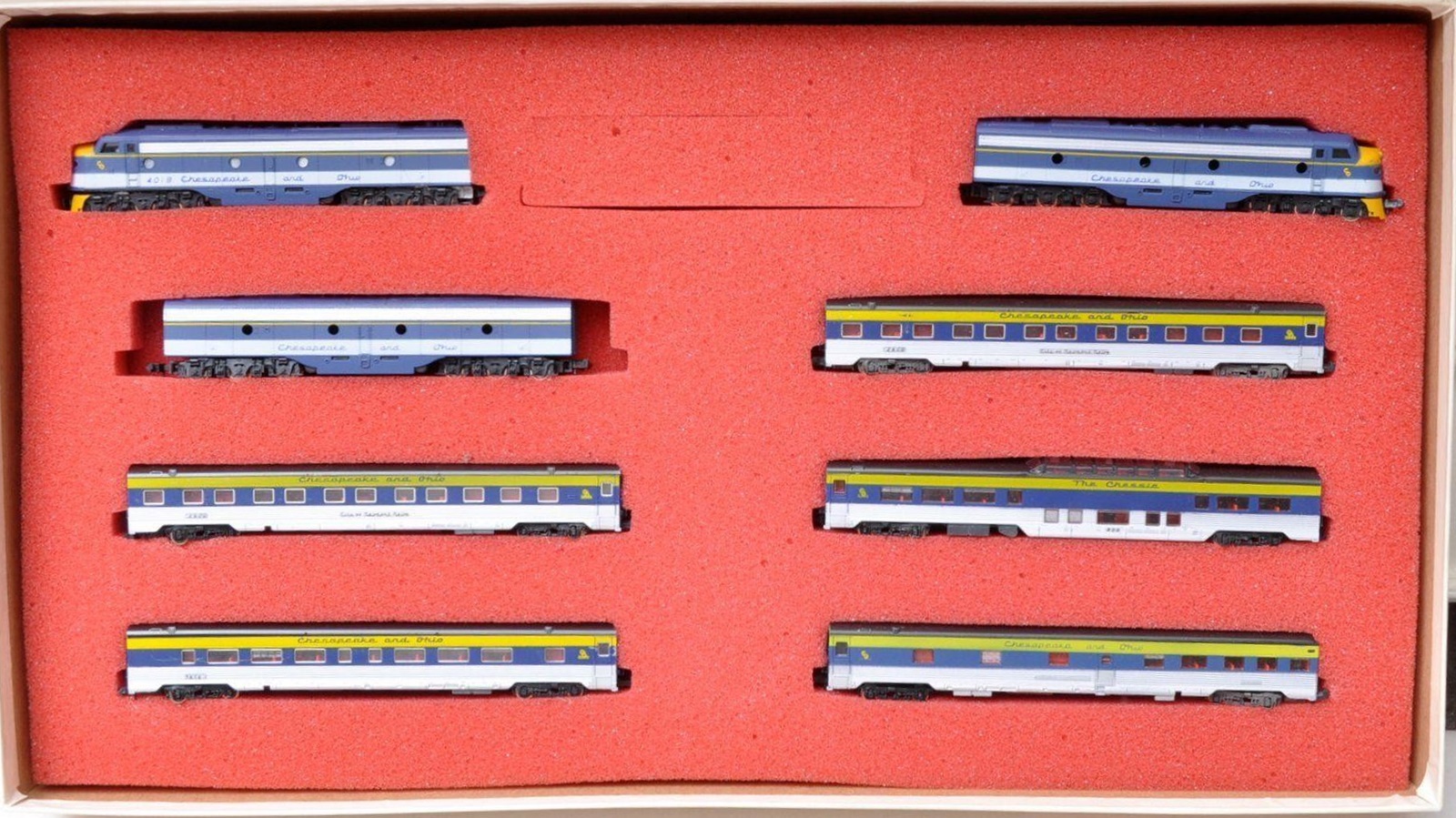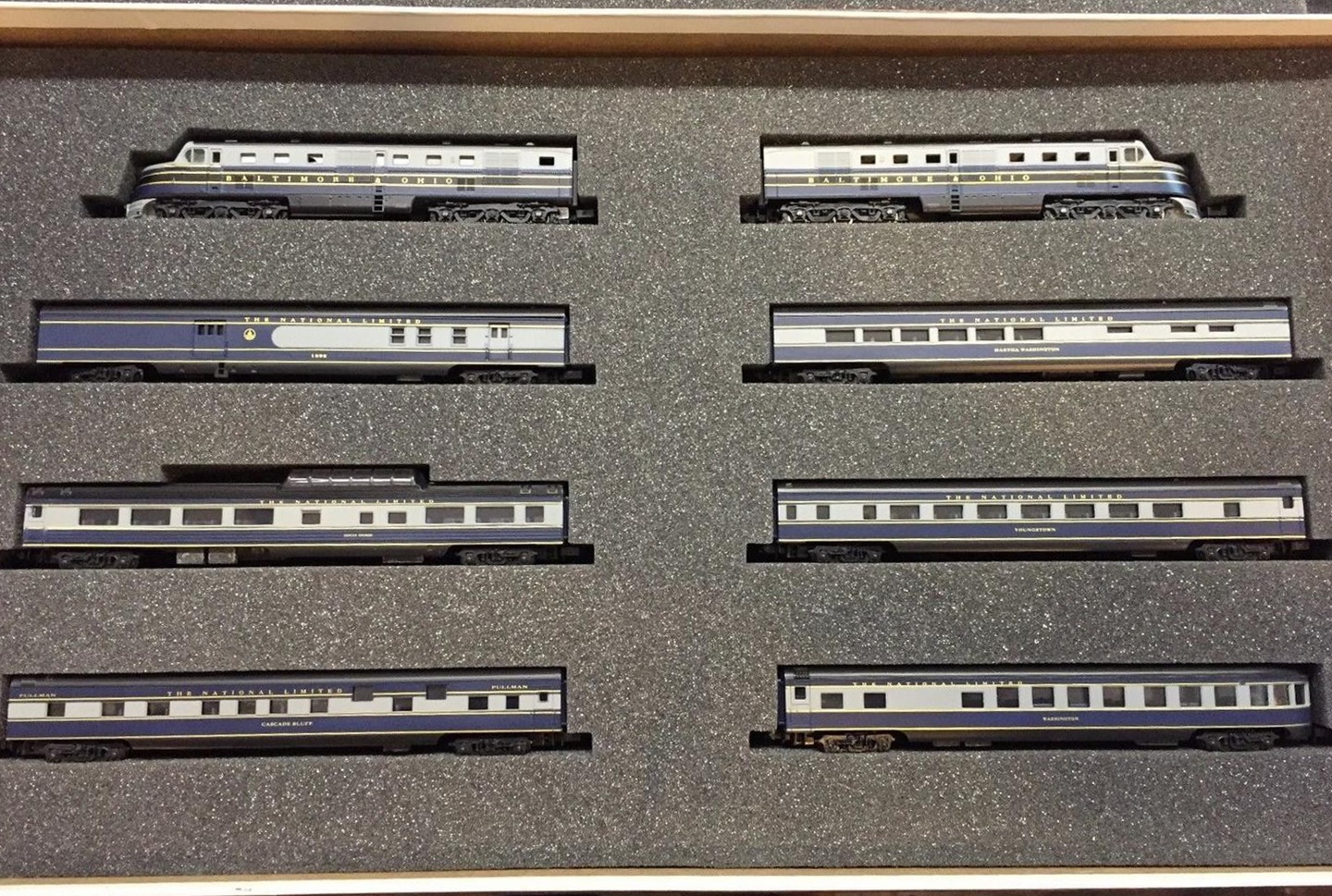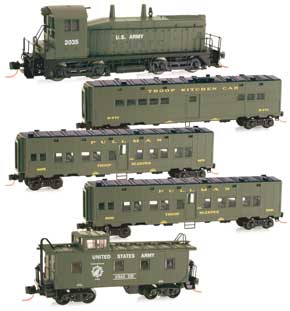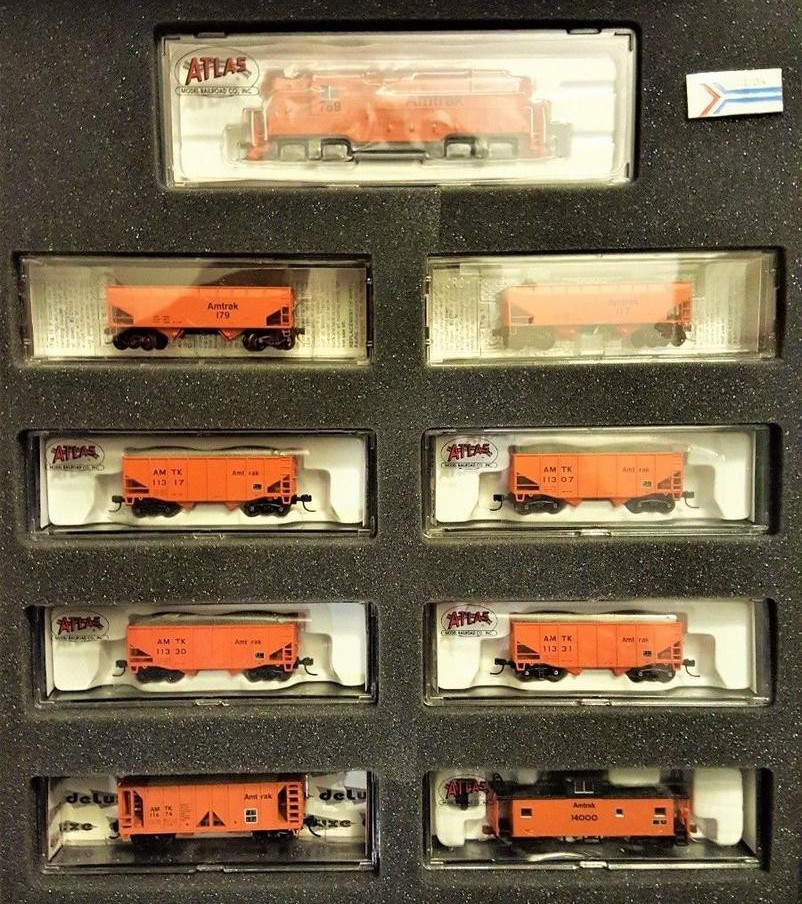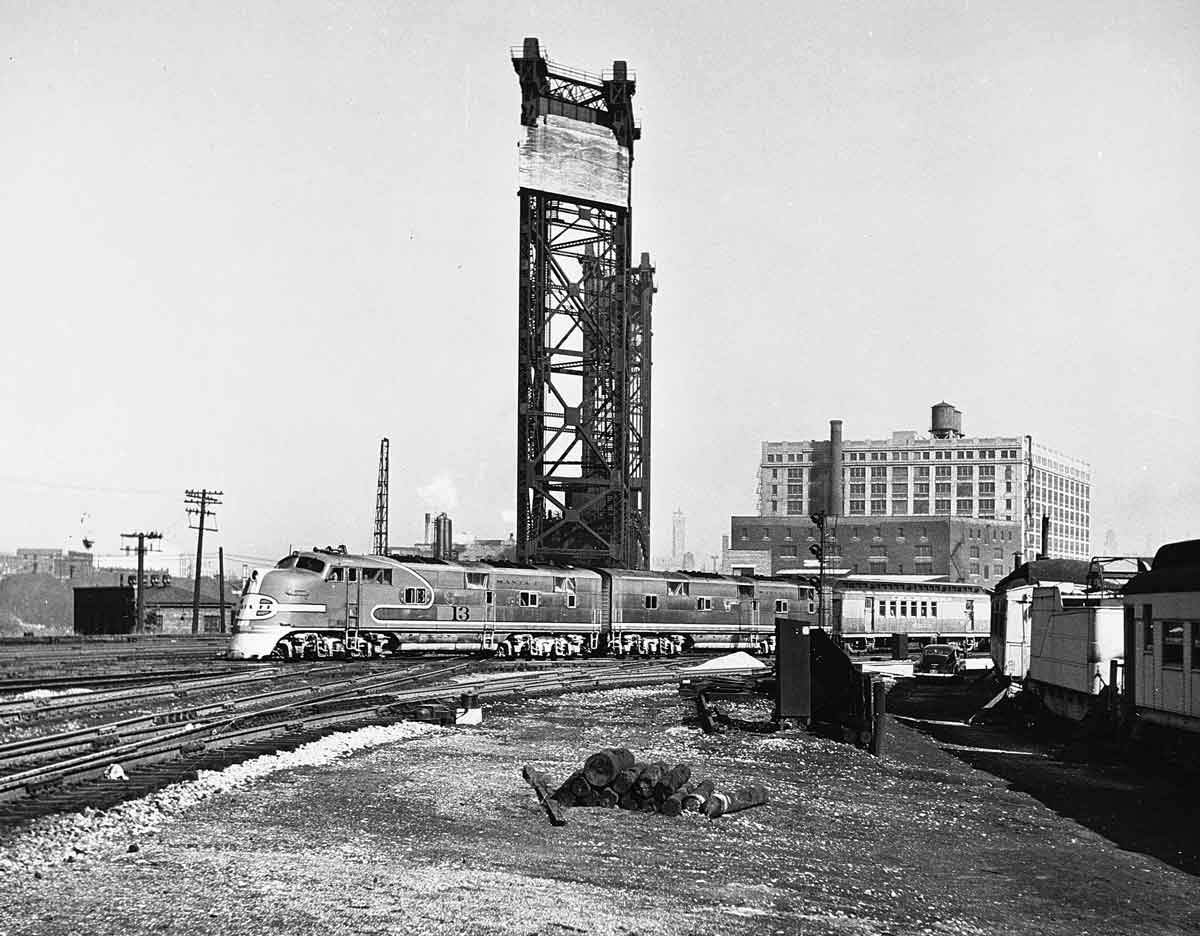Specific Item Information: Chesapeake & Ohio passenger car set: 3 diesel locomotives and 6 streamline smoothside cars.
- Diesel locomotives E8A #4018 (powered), E8B (dummy), E8A no# (dummy)
- 6 ConCor Heavyweight Cars Included
- Diesel locomotives E8A #4018 (powered), E8B (dummy), E8A no# (dummy)
- 6 ConCor Heavyweight Cars Included
Series Information: Con-Cor "Special Edition Sets" or "Special Limited Edition Sets" were the result of Con-Cor using the last of their stock of cars. Several new molds had to be made to accomplish this project as the original molds by Röwa had been destroyed in a fire. Several Röwa passenger cars in these sets were delivered unnumbered.
There has been two subseries:
First subseries - mid to end 1980s: These sets are furnished with usual wood-grained cardboard box that was used for the "Limited Edition sets'. The label does not have any mention of "Special" or "Limited" set. They contain locomotives and cars.
Second subseries - early 2000s: These sets were delivered in the colorful packaging 'Great American Trains' that was also used for the latest of the "Limited Edition Sets". They are marked " Special Edition Set" on the side label. They contain only cars; the matching locomotives were sold as separate items.
In this series, we have also listed sets that were delivered in the "Limited Edition Set" packaging, though not necessarily being 'Limited' in the sense that the locomotive and cars were generally available from open stock.
There has been two subseries:
First subseries - mid to end 1980s: These sets are furnished with usual wood-grained cardboard box that was used for the "Limited Edition sets'. The label does not have any mention of "Special" or "Limited" set. They contain locomotives and cars.
Second subseries - early 2000s: These sets were delivered in the colorful packaging 'Great American Trains' that was also used for the latest of the "Limited Edition Sets". They are marked " Special Edition Set" on the side label. They contain only cars; the matching locomotives were sold as separate items.
In this series, we have also listed sets that were delivered in the "Limited Edition Set" packaging, though not necessarily being 'Limited' in the sense that the locomotive and cars were generally available from open stock.
Prototype History: The transition era (1939 - 1957) was the heyday for passenger rail. The industrial boom triggered by the second world war created tremendous capacity for production which was no longer needed for war production. The North American factories turned to consumer goods and services and the rail system was a major recipient of this ouput.
The interstate highways system as we know it now was still a thing of the future and long distance travel by highway was simply not practical and aircraft travel was still a luxury for the well-to-do. People traveled the country by rail and there was a huge variety of railroads and services available to the traveler. Innovation was constant, and the materials and machinery employed by the railroads was evolving as fast as the engineers could think of new things to entice the fickle consumer to ride a particular route or particular service.
This all came to an end when the automobile and airplane replaced the passenger train as the preferred vehicles of transportation in the 1960s.
The interstate highways system as we know it now was still a thing of the future and long distance travel by highway was simply not practical and aircraft travel was still a luxury for the well-to-do. People traveled the country by rail and there was a huge variety of railroads and services available to the traveler. Innovation was constant, and the materials and machinery employed by the railroads was evolving as fast as the engineers could think of new things to entice the fickle consumer to ride a particular route or particular service.
This all came to an end when the automobile and airplane replaced the passenger train as the preferred vehicles of transportation in the 1960s.
Road Name History:  The Chesapeake and Ohio Railway (reporting marks C&O, CO) was a Class I railroad formed in 1869 in Virginia from several smaller Virginia railroads begun in the 19th century. Led by industrialist Collis P. Huntington, it reached from Virginia's capital city of Richmond to the Ohio River by 1873, where the railroad town (and later city) of Huntington, West Virginia was named for him.
The Chesapeake and Ohio Railway (reporting marks C&O, CO) was a Class I railroad formed in 1869 in Virginia from several smaller Virginia railroads begun in the 19th century. Led by industrialist Collis P. Huntington, it reached from Virginia's capital city of Richmond to the Ohio River by 1873, where the railroad town (and later city) of Huntington, West Virginia was named for him.
Tapping the coal reserves of West Virginia, the C&O's Peninsula Extension to new coal piers on the harbor of Hampton Roads resulted in the creation of the new City of Newport News. Coal revenues also led the forging of a rail link to the Midwest, eventually reaching Columbus, Cincinnati and Toledo in Ohio and Chicago, Illinois.
By the early 1960s the C&O was headquartered in Cleveland, Ohio, USA. In 1972, under the leadership of Cyrus Eaton, it became part of the Chessie System, along with the Baltimore and Ohio and Western Maryland Railway. The Chessie System was later combined with the Seaboard Coast Line and Louisville and Nashville, both the primary components of the Family Lines System, to become a key portion of CSX Transportation (CSXT) in the 1980s. A substantial portion of Conrail was added in 1999.
C&O's passenger services ended in 1971 with the formation of Amtrak. Today Amtrak's tri-weekly Cardinal passenger train follows the historic and scenic route of the C&O through the New River Gorge in one of the more rugged sections of the Mountain State. The rails of the former C&O also continue to transport intermodal and freight traffic, as well as West Virginia bituminous coal east to Hampton Roads and west to the Great Lakes as part of CSXT, a Fortune 500 company which was one of seven Class I railroads operating in North America at the beginning of the 21st century.
At the end of 1970 C&O operated 5067 miles of road on 10219 miles of track, not including WM or B&O and its subsidiaries.
Read more on Wikipedia.

Tapping the coal reserves of West Virginia, the C&O's Peninsula Extension to new coal piers on the harbor of Hampton Roads resulted in the creation of the new City of Newport News. Coal revenues also led the forging of a rail link to the Midwest, eventually reaching Columbus, Cincinnati and Toledo in Ohio and Chicago, Illinois.
By the early 1960s the C&O was headquartered in Cleveland, Ohio, USA. In 1972, under the leadership of Cyrus Eaton, it became part of the Chessie System, along with the Baltimore and Ohio and Western Maryland Railway. The Chessie System was later combined with the Seaboard Coast Line and Louisville and Nashville, both the primary components of the Family Lines System, to become a key portion of CSX Transportation (CSXT) in the 1980s. A substantial portion of Conrail was added in 1999.
C&O's passenger services ended in 1971 with the formation of Amtrak. Today Amtrak's tri-weekly Cardinal passenger train follows the historic and scenic route of the C&O through the New River Gorge in one of the more rugged sections of the Mountain State. The rails of the former C&O also continue to transport intermodal and freight traffic, as well as West Virginia bituminous coal east to Hampton Roads and west to the Great Lakes as part of CSXT, a Fortune 500 company which was one of seven Class I railroads operating in North America at the beginning of the 21st century.
At the end of 1970 C&O operated 5067 miles of road on 10219 miles of track, not including WM or B&O and its subsidiaries.
Read more on Wikipedia.
Brand/Importer Information: Con-Cor has been in business since 1962. Many things have changed over time as originally they were a complete manufacturing operation in the USA and at one time had upwards of 45 employees. They not only designed the models,but they also built their own molds, did injection molding, painting, printing and packaging on their models.
Currently, most of their manufacturing has been moved overseas and now they import 90% of their products as totally finished goods, or in finished components. They only do some incidental manufacturing today within the USA.
Important Note: The Con-Cor product numbering can be very confusing. Please see here in the article how to properly enter Con-Cor stock numbers in the TroveStar database.
Currently, most of their manufacturing has been moved overseas and now they import 90% of their products as totally finished goods, or in finished components. They only do some incidental manufacturing today within the USA.
Important Note: The Con-Cor product numbering can be very confusing. Please see here in the article how to properly enter Con-Cor stock numbers in the TroveStar database.
Item created by: james13pugh on 2022-04-26 15:46:09. Last edited by james13pugh on 2022-04-26 15:46:42
If you see errors or missing data in this entry, please feel free to log in and edit it. Anyone with a Gmail account can log in instantly.
If you see errors or missing data in this entry, please feel free to log in and edit it. Anyone with a Gmail account can log in instantly.


